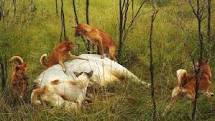
The Murchison Regional Vermin Council (MRVC)
“The Murchison Regional Vermin Council (MRVC)” was established in 1963 for the purpose of rehabilitation and maintenance of the No 1 Vermin Fence completed in 1907.
The fence was built in an endeavour to stem the rabbit hordes from eating their way west across from the other side of Australia.
The No 1 Vermin Fence was completed in 1907 and at the time was the longest unbroken line of fence in the world. The No. 1 fence runs from Starvation Boat Harbour on the south coast of WA to a point near Cape Keraudren on the north west coast.
Today the fence is an important barrier for the pastoralists of the region to prevent the spread of wild dogs, National economic losses to the sheep industry associated with wild dogs have been conservatively estimated to exceed $20 million a year and estimated to cost the beef industry more than $25 million as well as significantly reducing WA's native animal and domestic animal population.

“The Murchison Regional Vermin Council (MRVC)” comprises a group of shires in the Murchison region - Cue, Sandstone, Meekatharra, Yalgoo and Mt Magnet.
(Mount Magnet Murchison Regional Vermin Council Minutes)
The Council consists of ten members - two from each constituent Shire.
The fence that is under the control of the MRVC extends from the 80 mile peg in the South (Lake Moore), to the 426 mile peg in the North (Meekatharra/Wiluna Rd).
The aim is to build part of a 480 kilometre vermin proof fence which needs to be constructed between the existing State barrier fences - creating a vermin proof cell covering 7.5 million hectares and surrounding 53 pastoral stations and nine reserves.
One hundred kilometres of the fence has already been funded, the fence line has been cleared and construction has been completed.
The MRVC has requested just over $4.5 million from the WA Government through the Royalties for Regions program.
The draft WA Wild Dog Action Plan 2016-2021 is being finalised and will be presented to the Minister next month. This plan provides future direction for industry and public investment in controlling the threat of wild dogs.

Many West Australian pastoralists are warning there will be nobody left grazing sheep unless funding for a new wild dog fence is confirmed.
The flow-on effects from pastoralists destocking is significant as it means there is no work for shearers, fencers, caterers and shed hands, many of whom are local indigenous people
Wild dog sightings around mine sites and camps are also increasing, with many pastoralists and mining companies employing their own professional Doggers to control numbers.
To see further information and media articles on the Vermin Proof Fence click on the links below:
Meekatharra Rangelands Biosecurity Association
http://www.rangelandswa.com.au/
http://www.pestsmart.org.au/national-wild-dog-action-plan/case-studies/meekatharra/
The Pastoralists and Graziers Association (PGA)
http://www.pgaofwa.org.au/
Media articles:
http://www.abc.net.au/news/2015-06-29/wach-dog-money/6576496